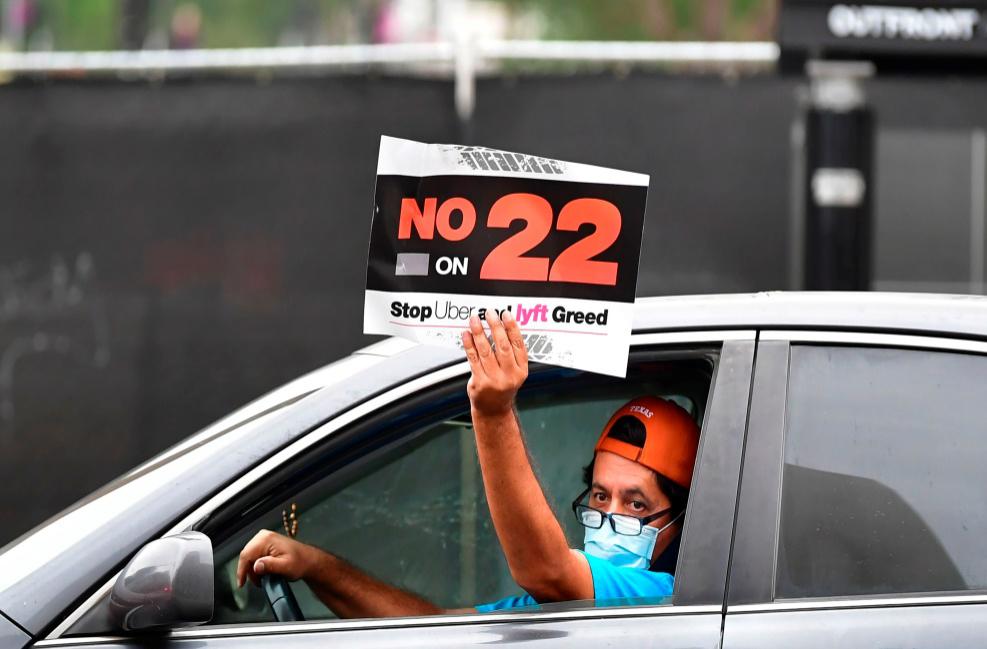美国网约车问题重重,造成社会伤害

在互联网经济中,零工工人应该拥有什么样的保障机制呢?
自然要包括医疗保险,还有养老金计划、病假、工伤和失业补偿。他们应当享受到公平、可转移的保障:假若零工工人在不同的公司做兼职,在换工作时,这些保障可以随岗迁移。
好消息是,我们知道怎样设计这种保障制度。坏消息是,数字平台公司一直没有把设计变成现实。
Uber和Lyft对于优化福利体系的诸多提案一清二楚。2015年,我的书《不公平交易:“Uber经济”和失控的资本主义如何压榨美国工人》(Raw Deal: How “Uber Economy” and Runaway Capitalism Are Screwing American Workers)出版后,我同两家网约车公司的高管见了面。我在会面中提出要建立“个人安全账户”——一个为司机和其他自由职业者设计的可迁移式保障计划,这是我们会面的一大重点议题。
我的想法是,每个工人名下都设立一个强制的、受政府监管的个人安全账户,每一家雇佣这些工人的企业都应该按照其在本公司工作时长向账户内拨付相应比例的资金。然后,工人能够使用账户资金支付医保、社保、病假、工伤和失业补偿等保障需求。
与其把灵活性放在安全性的对立面,也就是让零工工人在想要的工作和需要的福利间做选择,使用这种以“工时银行”系统为基础的可迁移式保障机制可以两者得兼。美国影视演员工会(Screen Actors Guild)、国际职员服务联盟(Service Employees International Union)和卡车司机工会(Teamsters)都有类似的多雇主计划。按照我的设想,在没有工会提供协调保障时,个人保险账户能够填补缺口。
美国前总统贝拉克•奥巴马在2016年的国情咨文中支持了我的想法。40位商界和政府领导——包括Lyft的联合创始人——签署了一份原则声明,呼吁建立可迁移式保障机制。Uber的首席执行官达拉•科斯罗萨西也呼吁落实此类机制。
但是,当各州支付可迁移保障机制的账单时,Uber和Lyft提供的资金并非员工工资的20%(根据联邦保险精算表,20%是建立足额保障所需的最低数额),而是仅仅2.5%。
有研究发现,如果过去五年Uber和Lyft的加州司机被划定为雇员而非独立承包人,它们单是向州失业保险基金支付的资金就超过4亿美元。然而,这些公司造成的巨大工资和福利缺口却不得不由加州纳税人买单。
因为这些公司没有足额缴款,加州议会通过了AB5法案,试图通过将司机重新归类为雇员而非独立承包人来解决这个问题。但Uber和Lyft拒绝执行该法律,开始推动第22号提案。
这些公司愿意在一项毁灭性的公投提案上花数亿美元,这么富有为什么不能对自己的员工好点呢?
答案是Uber和Lyft陷入了巨大的财务困境。它们每年亏损数十亿美元。出租车行业的利润率天生就很低,而它们用掠夺性的补贴模式进行低价竞争,每次行程补贴都超过成本的一半。
随着22号提案的通过,这些公司现在已经通过立法,形成了另一种葛朗台版的可迁移式保障机制,还试图通过调整最低工资来挽回颜面。第22号提案规定的医疗福利约为每小时1.2美元,远低于州和联邦法律规定的每小时4美元至6美元的雇员福利。
第22号提案看起来将司机的最低时薪调整为16.8美元。但请阅读细则:他们将使用一个复杂的公式,在计算最低工资时,只有“受雇小时数”(当司机车内有乘客时)才会被纳入工作小时数。
一名司机,如果一班10小时,可能只有5个小时车上载有乘客。如果司机在这一班赚了100美元,那么每小时也就只有10美元,低于加州法律规定的最低12美元的时薪。然而,按照22号提案的公式,计算结果为每小时20美元,也就意味着公司无需把不足的补齐。
如果选民否决了提案,司机仍然被算作正式雇员而不是独立承包人,那么司机能够得到的福利将远远超出22号提案。
Uber和Lyft的首席执行官们话说得很漂亮,说它们已经“准备好履行职责”为司机提供支持。但它们被自身无利可图的商业模式束缚住了手脚,而且,这种商业模式对司机、交通拥堵、环境和交通都有不利影响。社会还可以继续容忍这种商业模式多长时间?(财富中文网)
史蒂芬•希尔是书籍《不公平交易:“Uber经济”和失控的资本主义如何压榨美国工人》(How the “Uber Economy” and Runaway Capitalism Are Screwing American Workers)和《扩大社会保障:如何确保美国人得到他们应得的退休生活》(Expand Social Security Now: How to Ensure Americans Get the Retirement They Deserve)的作者。本文最初是为Zócalo Public Square撰写的。
译者:Agatha
在互联网经济中,零工工人应该拥有什么样的保障机制呢?
自然要包括医疗保险,还有养老金计划、病假、工伤和失业补偿。他们应当享受到公平、可转移的保障:假若零工工人在不同的公司做兼职,在换工作时,这些保障可以随岗迁移。
好消息是,我们知道怎样设计这种保障制度。坏消息是,数字平台公司一直没有把设计变成现实。
Uber和Lyft对于优化福利体系的诸多提案一清二楚。2015年,我的书《不公平交易:“Uber经济”和失控的资本主义如何压榨美国工人》(Raw Deal: How “Uber Economy” and Runaway Capitalism Are Screwing American Workers)出版后,我同两家网约车公司的高管见了面。我在会面中提出要建立“个人安全账户”——一个为司机和其他自由职业者设计的可迁移式保障计划,这是我们会面的一大重点议题。
我的想法是,每个工人名下都设立一个强制的、受政府监管的个人安全账户,每一家雇佣这些工人的企业都应该按照其在本公司工作时长向账户内拨付相应比例的资金。然后,工人能够使用账户资金支付医保、社保、病假、工伤和失业补偿等保障需求。
与其把灵活性放在安全性的对立面,也就是让零工工人在想要的工作和需要的福利间做选择,使用这种以“工时银行”系统为基础的可迁移式保障机制可以两者得兼。美国影视演员工会(Screen Actors Guild)、国际职员服务联盟(Service Employees International Union)和卡车司机工会(Teamsters)都有类似的多雇主计划。按照我的设想,在没有工会提供协调保障时,个人保险账户能够填补缺口。
美国前总统贝拉克•奥巴马在2016年的国情咨文中支持了我的想法。40位商界和政府领导——包括Lyft的联合创始人——签署了一份原则声明,呼吁建立可迁移式保障机制。Uber的首席执行官达拉•科斯罗萨西也呼吁落实此类机制。
但是,当各州支付可迁移保障机制的账单时,Uber和Lyft提供的资金并非员工工资的20%(根据联邦保险精算表,20%是建立足额保障所需的最低数额),而是仅仅2.5%。
有研究发现,如果过去五年Uber和Lyft的加州司机被划定为雇员而非独立承包人,它们单是向州失业保险基金支付的资金就超过4亿美元。然而,这些公司造成的巨大工资和福利缺口却不得不由加州纳税人买单。
因为这些公司没有足额缴款,加州议会通过了AB5法案,试图通过将司机重新归类为雇员而非独立承包人来解决这个问题。但Uber和Lyft拒绝执行该法律,开始推动第22号提案。
这些公司愿意在一项毁灭性的公投提案上花数亿美元,这么富有为什么不能对自己的员工好点呢?
答案是Uber和Lyft陷入了巨大的财务困境。它们每年亏损数十亿美元。出租车行业的利润率天生就很低,而它们用掠夺性的补贴模式进行低价竞争,每次行程补贴都超过成本的一半。
随着22号提案的通过,这些公司现在已经通过立法,形成了另一种葛朗台版的可迁移式保障机制,还试图通过调整最低工资来挽回颜面。第22号提案规定的医疗福利约为每小时1.2美元,远低于州和联邦法律规定的每小时4美元至6美元的雇员福利。
第22号提案看起来将司机的最低时薪调整为16.8美元。但请阅读细则:他们将使用一个复杂的公式,在计算最低工资时,只有“受雇小时数”(当司机车内有乘客时)才会被纳入工作小时数。
一名司机,如果一班10小时,可能只有5个小时车上载有乘客。如果司机在这一班赚了100美元,那么每小时也就只有10美元,低于加州法律规定的最低12美元的时薪。然而,按照22号提案的公式,计算结果为每小时20美元,也就意味着公司无需把不足的补齐。
如果选民否决了提案,司机仍然被算作正式雇员而不是独立承包人,那么司机能够得到的福利将远远超出22号提案。
Uber和Lyft的首席执行官们话说得很漂亮,说它们已经“准备好履行职责”为司机提供支持。但它们被自身无利可图的商业模式束缚住了手脚,而且,这种商业模式对司机、交通拥堵、环境和交通都有不利影响。社会还可以继续容忍这种商业模式多长时间?(财富中文网)
史蒂芬•希尔是书籍《不公平交易:“Uber经济”和失控的资本主义如何压榨美国工人》(How the “Uber Economy” and Runaway Capitalism Are Screwing American Workers)和《扩大社会保障:如何确保美国人得到他们应得的退休生活》(Expand Social Security Now: How to Ensure Americans Get the Retirement They Deserve)的作者。本文最初是为Zócalo Public Square撰写的。
译者:Agatha
What would a safety net look like for gig workers in the Internet-based economy?
It would provide health insurance, naturally, and a retirement plan, sick leave, and injured worker and unemployment compensation. And it would be equitable and portable: A person working part-time for different companies would have robust benefits that travel with them from job-to- job.
The good news is that we know how to design that sort of safety net. The bad news is that the digital platform companies keep missing opportunities to make it a reality.
Uber and Lyft are well aware of proposals to build better benefits systems. Following the publication of my book, Raw Deal: How the ‘Uber Economy’ and Runaway Capitalism Are Screwing American Workers in 2015, I met with executives at both ride-sharing firms. A central part of the discussions was my proposal for an “Individual Security Account,” a portable safety net for drivers and for other freelance workers.
My idea was that each worker would have a mandatory, government-regulated Individual Security Account, and that any business that hires a worker would contribute an amount pro-rated to the number of hours worked for that business. The worker would then use those funds to pay for safety net needs such as health care, Social Security, sick leave, injured worker and unemployment compensation.
Instead of pitting flexibility against security—making a gig worker choose between the work they want and the benefits they need—a portable safety net based on this kind of an “hours bank” system would allow for both. (The Screen Actors Guild, the Service Employees International Union, and the Teamsters all manage these kinds of multi-employer plans). The Individual Security Account, as I envisioned it, would fill in the gap when there is no labor union to coordinate contributions.
President Barack Obama endorsed my idea in his 2016 State of the Union address. Forty business and government leaders—including the co-founders of Lyft—signed a statement of principles calling for a portable safety net. Uber CEO Dara Khosrowshahi also called for enacting a portable safety net plan.
But when bills for portable safety nets were introduced in states, Uber and Lyft, rather than contributing 20% of a worker’s wages (the minimum necessary to fund an adequate safety net according to federal actuarial tables) offered to contribute 2.5%.
One study found that if their California drivers had been classified as employees rather than contractors these last five years, Uber and Lyft would have paid more than $400 million into the state unemployment insurance fund alone. Instead, California taxpayers have had to foot the bill for the significant wage and benefit gaps created by these companies.
Without a serious offer from the companies, the California legislature passed AB5, which attempted to solve the problem by reclassifying drivers as employees rather than independent contractors. Uber and Lyft refused to implement the law, and pursued Proposition 22 instead.
Why can’t these companies, rich enough to spend hundreds of millions of dollars on a ruinous ballot measure, do better by their workers?
The answer is that Uber and Lyft are in huge financial trouble. They lose billions of dollars every year. Profit margins are inherently low in the taxi business, and their predatory model subsidizes more than half the cost of every ride in a bid to undercut competition.
With the passage of Prop 22, the companies have now legislated into existence another miserly version of a portable safety net, along with a face-saving attempt at a minimum wage. The value of Proposition 22’s health benefit is estimated at about $1.20 an hour—well below the $4 to $6 hourly value of benefits mandated for employees under state and federal laws.
Proposition 22 also appears to offer to drivers a new hourly minimum wage of at least $16.80 per hour. But read the fine print: A complex formula will be used in which only “engaged hours” (when the driver has a passenger in the car) will be counted as hours worked when calculating the minimum wage.
A driver, in a 10-hour shift, might only have passengers for five hours. If the driver earns $100 in that shift, that would amount to only $10 per hour—less than California’s legal minimum wage of $12 per hour. Yet the Prop 22 formula will calculate that wage as $20 per hour, meaning the companies will have no obligation to top it up.
None of Prop 22’s offerings come close to what drivers would receive if voters had rejected the initiative and drivers had remained regular employees instead of independent contractors.
The CEOs of Uber and Lyft talk a good game, saying they are “ready to do their part” to help their drivers. But they are hamstrung by their own unprofitable business model, which has also turned out to be bad for many of their drivers, for traffic congestion, for the environment, and for transportation. How much longer can society afford to allow this business model to continue?
Steven Hill is the author of Raw Deal: How the ‘Uber Economy’ and Runaway Capitalism Are Screwing American Workers and Expand Social Security Now: How to Ensure Americans Get the Retirement They Deserve. He originally wrote this article for Zócalo Public Square.













